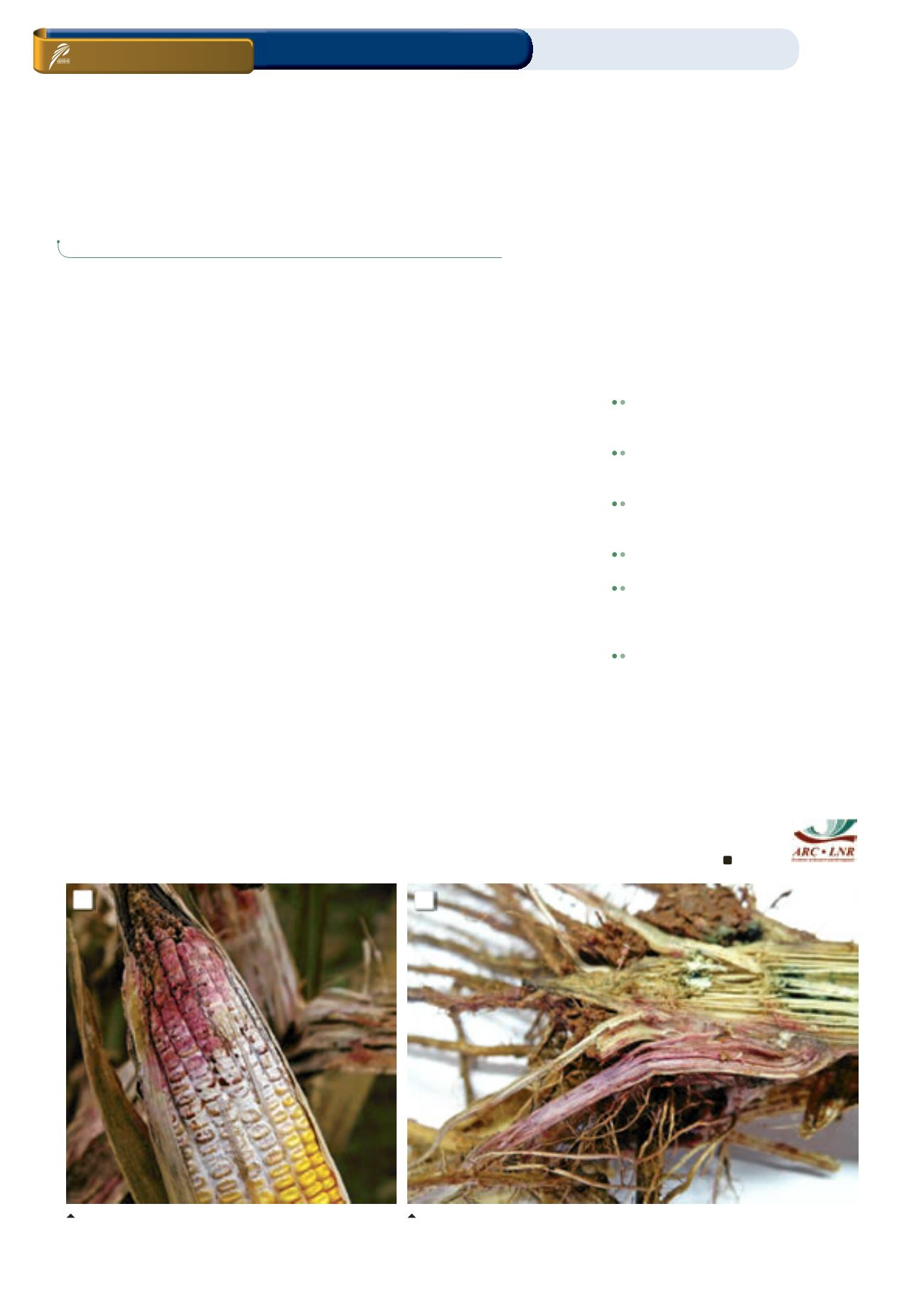
88
Thebasics of
Fusariumgraminearum
species complex (red rot) inmaize
M
aize is the staple food com-
modity in South Africa and it is
plagued by many ear and stem
rot diseases.
The fungi infectingmaize can also produce
mycotoxins, which are toxic substances.
Mycotoxicoses can cause various diseases
inhumans andanimals. In this article the fo-
cus will be on the
Fusarium graminearum
species complex and their resultant myco-
toxins.
Gibberella ear, crown, root and stalk rots
are widespread throughout the South Afri-
can maize production area. Globally these
diseases are caused by 16 fungal species
belonging to the
Fusarium graminearum
species complex. However, only three spe-
cies have been found on South African
maize thus far.
Gibberella ear rot usually occurs where
maize is produced under wet, warm condi-
tions. The disease has been common in the
moderate easternproduction areas andhas
recently been noticed to be on the increase
in thewesternproduction areas. Thepatho-
gen can also infect wheat, oats andbarley.
Maize grown in monoculture or rotation
with other graminaceous crops can increa-
se disease levels depending on the amount
of inoculum that is carried over from one
crop to the next. The disease can also in-
crease in reduced tillage fields because of
an increase in inoculum levels due to stub-
ble retention. Gibberella ear rot can cause
yield losses and affect grain quality, while
root, crown and stalk rots can also have fi-
nancial implications.
Ear infections initially appear as white fun-
gal growth on the ear tips which grow to-
ward the base of the ears (
Photo 1
). The
myceliumwill later turn red-pink in infected
kernels. If thedisease startsearlyduring the
growth stageof thedevelopment of the ear,
the mycelia may cover the whole ear and
tightly adhere thehusks together.
Symptoms of root, crown and stalk rots be-
come evident by the appearance of brown
or discoloured patches in a field, by un-
even growth, plants that become chlorotic
or show symptoms of dwarfing. In severe
cases theplantswill lodge.
When infected roots, crowns or stems are
cut open, acharacteristicpink to red tingeof
the tissue (
Photo 2
) is visible. It is important
to send diseased material to an institution
that can help correctly identify the fungal
species causing thedisease.
The fungi in this complex are known topro-
duce mycotoxins such as deoxynivalenol
(DON), nivalenol (NIV) and the estrogenic
metabolite zearalenone (ZEA), which are
harmful tohumans and livestock.
NIV and DON are known protein synthesis
inhibitorsand theconsumptionofgraincon-
taminatedwith thesemycotoxins can cause
anaemia, skin lesions, vomiting, diarrhoea,
and damage to haematopoietic (liver) tis-
sues in humans and animals. Zearalenone-
contaminated feed can lead to animals
developing reproductiveproblems.
Control measures
Host-resistant or -tolerant varieties are
the most cost-effective and practical
means of combating thedisease.
Avoid planting maize at unacceptably
high population densities as this in-
creases stress and crop susceptibility.
Rotate with non-hosts of the
Fusarium
graminearum
species complex such as
legumes, cottonor sunflower.
Harvest early to avoid losses due to
lodging.
Control insects such as stalk borers
which may serve as possible vectors,
observing the threshold valueof 10%of
infestedplants for chemical control.
Inorder toprevent ear rot after harvest,
storegrainunder lowmoistureand tem-
peratures.
At theARC-GCI we areperforming research
on the
Graminearum
complex andwe focus
on Gibberella root, crown and stalk rot, as
well asGibberella ear rot onmaizeplants.
For any questions, please
contact Aneen Schoeman at
or
018 299 6254/6100.
ON FARM LEVEL
Ear rot / Stem rot /Maize /Mycotoxins
Integratedpest control
ANEENSCHOEMAN
and
SONIA-MARI GREYLING,
ARC-GrainCrops Institute
1:Gibberella ear rot causedby the Fusariumgraminearum
species complex.
Photo:
/
agronomy/crop-management/corn-insect-disease/gibberella-ear-
rot/
2: The characteristic pinkdiscolourationof root tissue infectedby the Fusarium
graminearum species complex.
1
2
Oktober 2014


